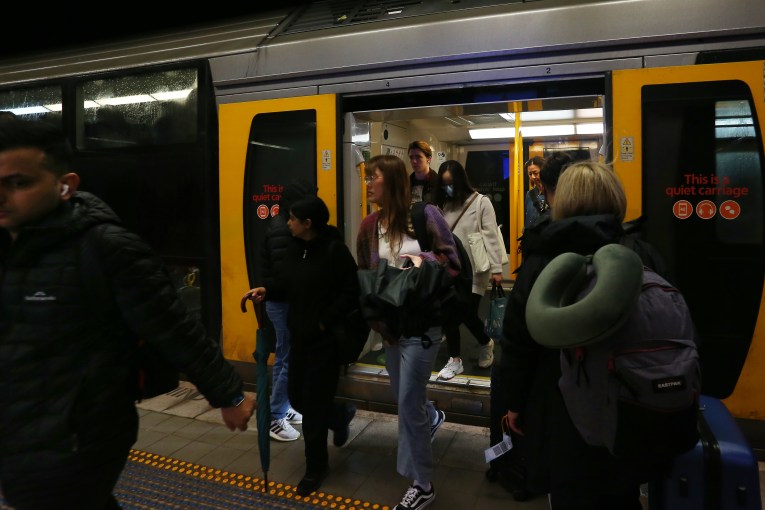From explosion to implosion: How Rio Tinto blew up the Juukan Gorge – and itself

It was late May. Much of the country was preparing for winter, trying to cope with the idea of a long, cold lockdown, but in the Pilbara, it was a blistering afternoon.
Our iconic orange sun hit the red sand in that breathtaking Australian way. Picture perfect.
The hum from the nearby mining area swept on the breeze across the Hamersley Range.
The mountains were wrapped in silence. And then an explosion. Two rock shelters in Juukan Gorge blown to bits.
In a few loud minutes, evidence of 46,000 years of continual occupation on this land just vanished.
The most precious piece – a 4,000-year-old braid of human hair, proving a genetic link to the traditional owners alive today – gone, in seconds.
It was the Sunday before Reconciliation Week, and Rio Tinto, one of the biggest mining companies in Australia, just blew up the only inland site that showed signs of continual human occupation through the last Ice Age.

Rio Tinto was given permission to blast Juukan Gorge 1 and 2 under Section 18 of the Aboriginal Heritage Act. Photo: Puutu Kunti Kurrama And Pinikura Aboriginal Corporation
The decision caused global outrage, sparked an ongoing parliamentary inquiry and became one facet of the Black Lives Matters protests in Australia, which saw thousand march around the country.
On Friday the heads of chief executive, Jean-Sébastien Jacques and two other senior executives rolled for destroying the sacred site.
Rio Tinto said Mr Jacques was leaving “by mutual agreement” but really, they had bowed to intense investor pressure for strong action.
Activist shareholders wanted corporate blood – and along with Mr Jacques, they got the the iron ore head, Chris Salisbury, and the corporate affairs boss, Simone Niven.

Juukan Gorge in 2013 and in 2020 after the land was cleared.
But commentators and indigenous advocates say that will likely not be enough to reverse the damage done in those short explosive seconds.
Rio Tinto had known for years the importance of what they had blown up.
Because of outdated laws that favour mining companies, Rio Tinto had been granted permission to interfere with the site by the state government in 2013 – a year before archaeological surveys revealed how important it was.
After the explosion, the traditional owners, the Puutu Kunti Kurrama and Pinikura (PKKP) people, said they were ‘devastated’ by the loss.
“Our people are deeply troubled and saddened by the destruction of these rock shelters and are grieving the loss of connection to our ancestors as well as our land,” PKKP land committee chair John Ashburton said.
“Losing these rock shelters is a devastating blow to the PKKP Traditional Owners.”
In August, Mr Jacques told the parliamentary Inquiry that the company had reviewed four options, three of which would have avoided damage to the scared site.

Rio Tinto’s CEO Jean-Sebastien Jacques will stand down next year.
“The difference between option four and the other three options was 8 million tonnes of high-grade iron ore,” Mr Jacques said.
“The economic value was around $135m of net value at the time of the decision.”
The PKKP were in the dark about the three other options until the inquiry, and they only learnt about the demolition 11 days before it was scheduled.
They tried to stop it – but were told the charges had already been laid and could not safely be removed.
The aftermath was brutal.
Rio Tinto publicly apologised but behind closed doors things were different.
A recording leaked to the Australian Financial Review from an internal company ‘townhall’ showed Mr Salisbury was only sorry for the distress it cased – not the action itself.
“That’s why we haven’t apologised for the event itself, per se, but apologised for the distress the event caused”, he told employees.

Evidence of over 40,000 years of human habitation was found when one of the Juukan rock cave sites was excavated in 2014. Photo supplied
Pressure mounted. Shareholders grew angry. The board was divided on how to manage the crisis. It misread the room and stripped Mr Jacques, Mr Salisbury and Ms Niven of $7 million in short-term bonuses.
It wasn’t enough.
HESTA, one of Australia’s biggest superannuation funds called for a public inquiry into all agreements Rio Tinto made with Aboriginal traditional owners.
In a letter, the Australasian Centre for Corporate Responsibility (ACCR), a Rio shareholder, said the demolition “squandered” the companies social licence.
Investors queued up to denounce the board’s decision to strip bonuses, saying it just wasn’t enough – they needed to go.
But with their resignations the issue has not gone away, said James Fitzgerald from The Australasian Centre for Corporate Responsibility.
“I would add that the leadership problem is not solved; in fact, there were two disasters here,” he said.

Rio Tinto’s actions were met with backlash from both the public and shareholders.
“There was the destruction of Juukan Gorge, but then there was the most extraordinary failure of leadership at the top end of Rio Tinto, at its board, in the months afterwards.”
He said mining companies all over the Pilbara were still taking advantage of what are acknowledged to be sub-standard cultural heritage protection laws, and they should pay attention to what’s transpired here.
“Investors have stepped up in this instance and demonstrated that they will not accept corporate misinformation and the absolute disrespect to cultural sites that have become Rio’s modus operandi,” Mr Fitzgerald said.
“Shareholder democracy and investor action is alive and well in Australia. Corporate captains may think twice before attempting to mislead investors, not to mention a Parliamentary Inquiry, in future.”
Forward, but on their terms
Investors have welcomed the decision, but the PKKP are quiet.
“The PKKP people have no comment to make about the changes to Rio Tinto’s senior executive announced today,” the PKKP corporation said in a statement on Friday.
It will continue to work with Rio Tinto in the aftermath of the Gorge disaster and focus on preserving cultural sites, it said.
“We cannot and will not allow this type of devastation to occur ever again.”
Professor Marcia Langton, who as recently as 2013 was a champion of Rio Tinto’s leadership in Aboriginal relations, linked the ‘corporate culture’ back to Mr Jacques but said it was time for the mining giant to listen.
“They need to get smart now and listen to what we’re saying to them,” she said.

Rio Tinto accumulated an $11 billion profit in 2017.
“For too long Rio Tinto has treated our cultural heritage with contempt.
“They need to conduct a series of round tables with Indigenous leaders. London is a long way away and it’s time for the board itself to educate itself as to the concerns herein Australia.”
Not only does the board need to start listening to traditional elders, but there also needs to be a commitment from the WA government to change the legislation and a national definition of cultural heritage, she said.
“Rio Tinto’s social licence to operate has been stripped away, so they better start taking advice from the people who really matter,” Professor Langton said.
Otherwise, Australia could lose hundreds of more sites similar to the Gorge.
“There are hundreds of section 18 authorised sites in WA alone,” she said.








